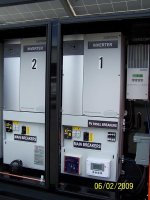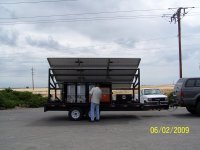The problem with that is that I would only be getting 2/3 of the power and still need the 5 hp.
It is not clear what you are talking about. If you only need 3-phase 240 volts for the ride motor, then you do not need
another inverter. What you need is a Variable-Frequency Motor Drive, a special-purpose electronic device that is designed to take an AC input, convert it to DC, then converts the DC to AC by rapid transistor switching, to produce a syhthensized variable AC output, either 1-phase
OR 3-PHASE. If you mean that you need to convert single phase 240 volts to 3-phase 208 volts, then buy a 7.5 HP. variable speed drive, with the option for 1-phase IN, 3-phase out, and you should have enough power (2/3 of 7.5 = 5 HP) to run a 5 HP. motor. The properly-chosen VFD will run off your existing 50 Amp 240 volt inverter to produce 3-phase 240 volts AC power for the 5 HP. motor.
The ride currently has a 5hp Sumotomo AF502 220 3ph invertor.
I seriously doubt that. True 220 volt 3-phase power is very rare. It might be 3-phase 208 volts, or 3-phase 240 volts. I also question if your 1-phase inverter output voltage actually measures 220 volts with a voltmeter.
1-phase 220 volts in the U.S. is the minimum nominal equipment voltage, the lowest voltage for which a piece of equipment must be designed to operate. Usual actual supply voltage ranges from 240 to 250 volts 1-phase AC. If your inverter is only producing 220 volts, then it output badly needs adjusting upwards. Running any motor at 220 volts is aksing for trouble. The current will be high, causing overheating of the motor, the wiring, and the contactors.





